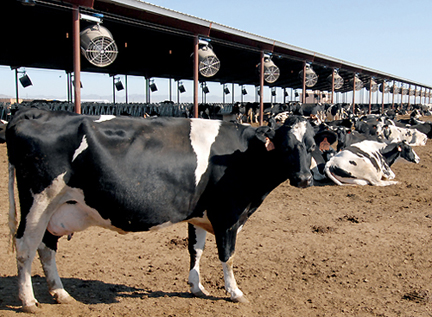Dairy cows like cool weather; they do not do like heat or humidity. Some management experts have even described them as "little heaters inside a leather bag."

Cows dissipate body heat by panting, but their ability is limited. When that ability is exceeded by the temperature load placed on them, they suffer heat stress. That causes lower feed intake, lower milk production, poor reproduction, and higher disease risk. Death is possible in extreme cases.
Cows respond well to being cooled with fans or water, especially when they are used together. Where, how, when, and how long cow cooling should be done are different for each dairy. But the bottom line advice that experts give to dairy managers about cow cooling is, do some. Here are 9 tips (in order) where they say you should start:

Cows dissipate body heat by panting, but their ability is limited. When that ability is exceeded by the temperature load placed on them, they suffer heat stress. That causes lower feed intake, lower milk production, poor reproduction, and higher disease risk. Death is possible in extreme cases.
Cows respond well to being cooled with fans or water, especially when they are used together. Where, how, when, and how long cow cooling should be done are different for each dairy. But the bottom line advice that experts give to dairy managers about cow cooling is, do some. Here are 9 tips (in order) where they say you should start:
- Supply adequate water. Heat-stressed cows need up to 100 percent more water than normal.
- Provide shade in both the milking parlor holding pen and the housing area for milking cows and dry cows alike.
- Reduce walking distance to the parlor.
- Reduce standing time in the holding pen.
- Improve ventilation in the holding pen and in free stalls.
- Add cooling to the holding pen and exit lanes.
- Provide cooling for closeup cows, especially those within three weeks of calving.
- Provide cooling in fresh cow and early-lactation cow housing areas.
- Provide cooling in mid- and late-lactation cow housing areas.









